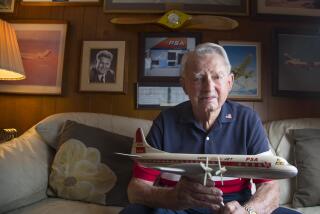Aviator Found the Right Path
- Share via
Tony LeVier, a Lockheed test pilot for 33 years, was the first person to fly the XP-80A Shooting Star, the Mach-2 XF-104, the U-2 spy plane and many others. When he was 16 he had second thoughts about climbing back into a cockpit, but he took his mother’s advice and never looked back. LeVier, 77, is a flight safety consultant for Lockheed and president of S.A.F.E., Safe Action in Flight Emergency Inc. LeVier and his wife, Neva Jean, live in La Canada.
I was born in Duluth, Minn., February the 14th, 1913. One of the coldest spots on earth. My mother, a very sharp individual, figured she had to get the family out of that climate, and the best spot is Southern California.
We left Duluth on Armistice Day, 1918, and as I crossed the main street I heard this strange noise, and I looked up and saw an airplane, a World War I training plane called the Curtis JN-4, “Jenny” for short.
I had never seen an airplane. It was an exciting moment to see this thing. We moved to Venice, Calif., and we ended up within two blocks of an airport, which was loaded with these Jennies that I’d seen just a few days before.
In 1927 Charles Lindbergh launched his little airplane from Roosevelt Field in New York, to go 3,600 miles to Paris, France.
This was exciting to everybody, my mother in particular--she was a very forward, advanced woman.
The morning of the 22nd of May we heard he had landed.
It was 7 o’clock in the morning at breakfast and we were gathered around the radio. I announced then that I was going to become an aviator. The first remark my mother said was, “Why Tony, that’s wonderful. Just remember, be a good one.”
Now the summer of 1928 comes along and one of the young boys and I went to the Balboa Theater Sunday night.
We were barefooted and going down the aisle I noticed what appeared to be a dollar bill and I picked it up with my toes, palmed it and went to the seat. It turned out to be a ten-dollar bill. And the first thought came to mind, “Tomorrow morning I’m going to go take my first flying lesson.”
It was a hot day and there wasn’t anybody around the field, just the airplane and the pilot.
And I told him I would like a flying lesson, and he gave me 20 minutes for $5. I didn’t blow the whole ten.
I remembered one thing that he told me just as I was crawling in.
He said, “I want you to keep a sharp lookout for other airplanes, keep your head swiveling.” I never forgot that. The importance of watching out for other airplanes never left me, and I know that that saved my life through my career in aviation.
In 1929 I got my third official flying lessons by a fine pilot by the name of Vernon Durrell.
He took me up and introduced me to side slips and skids, and then he took me up and stalled me.
Then he climbed up further, and he said, “When an airplane stalls it can also spin.” I was really up-tight, but I didn’t let out a peep.
It was a very weird sensation and once it got started, you felt this swirl, but it looked like the world was turning.
It went about two turns and he kicked it to the right and out we came, and I was sick to my stomach.
I didn’t upchuck but I was just terrified because what came to my mind was, “I’ve got to do this to become a pilot, how can I do it?”
We landed and I went out to the curb and I pondered my fate. “Here I am, 16 years old, I absolutely pledged myself to aviation, and this one incident has changed my whole attitude.” I didn’t think I was up to it.
I went home, walked in the front door, my mother was always there to meet me. I had the long face, and she said, “Tony, what in the world is the matter, what happened?” And I told her this story of the flight, and how it terrified me.
You know what my mother said? “Why Tony, after a good meal and a good night’s rest it’ll be a different day.” That’s all she said. And the next morning I was ready to go again.
More to Read
Sign up for The Wild
We’ll help you find the best places to hike, bike and run, as well as the perfect silent spots for meditation and yoga.
You may occasionally receive promotional content from the Los Angeles Times.




